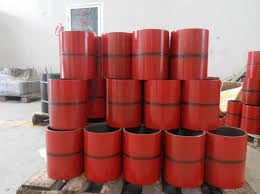well tubing and casing
Well Tubing and Casing Essential Components in Oil and Gas Extraction
In the oil and gas industry, the extraction process is a complex operation that relies heavily on specialist equipment and technologies. Among these, well tubing and casing are crucial elements that ensure the efficient and safe retrieval of hydrocarbons from beneath the Earth's surface. Understanding these components and their functions is vital for anyone involved in the industry, from engineers to geologists.
What is Well Casing?
Well casing refers to the steel pipe that is installed in the drilled borehole to protect the well and the surrounding environment. Once a well has been drilled to a specific depth, casing is placed inside the hole, providing structural integrity and preventing it from collapsing. Casing also isolates the wellbore from the surrounding rock formations, which is especially important in avoiding the contamination of freshwater aquifers. Typically, casing is cemented into place to create a seal that further enhances the well's stability and safety.
Casing comes in various sizes and types, each designed for specific applications. For instance, surface casing is installed at the top of the well to stabilize the borehole, while intermediate casing provides additional protection, and production casing, installed in the production zone, is designed to withstand high pressures and corrosion from the extracted fluids. The choice of casing is critical, as it must be strong enough to withstand the physical and chemical stresses encountered during the extraction process.
What is Well Tubing?
Well tubing, on the other hand, is a smaller-diameter pipe installed inside the casing after drilling and completion of the well. Tubing is the conduit through which oil and gas are produced to the surface. Unlike casing, which remains in place primarily for support and protection, tubing is replaced periodically due to wear and potential failure.
The tubing allows for the transfer of oil and gas fluids from the reservoir to the surface, where they can be processed and transported. Tubing must be designed to handle not only the pressure from the fluids but also the corrosion and erosion caused by the produced hydrocarbons and other fluid constituents. High-quality materials, such as carbon steel and stainless steel, are often utilized to enhance durability.
well tubing and casing

Importance of Well Tubing and Casing
The integrity and efficacy of well tubing and casing are critical for various reasons. First, they protect both the environment and the well itself. Properly installed casing prevents leaks and contamination of groundwater, which is a significant concern in oil and gas operations. Additionally, well integrity ensures that the extraction process can be conducted safely, mitigating the risk of blowouts and other catastrophic failures.
Second, they contribute to the overall efficiency of hydrocarbon recovery. A well-designed and maintained wellbore allows for maximum flow rates and minimizes the risk of downtime due to equipment failure. This efficiency is not only economically beneficial for operators but also essential for meeting global energy demands sustainably.
Challenges and Innovations
Despite the robust design of well tubing and casing, operators often face challenges such as corrosion, casing leaks, and mechanical failures. Innovations in materials science and engineering aim to address these issues. For example, the use of corrosion-resistant alloys and advanced seals can extend the life of tubing and casing. Additionally, real-time monitoring technologies enable operators to detect potential failures before they occur, reducing the risk of environmental harm and operational loss.
Conclusion
In conclusion, well tubing and casing are indispensable components in the oil and gas extraction process. Their design, installation, and maintenance are critical to ensuring safe, efficient, and environmentally responsible operations. As technology advances, the industry continues to innovate to overcome existing challenges, ensuring that these essential elements can meet the demands of future extraction efforts. Understanding the significance of well tubing and casing not only helps industry professionals but also emphasizes the importance of responsible resource management in an increasingly energy-dependent world.
-
Unlock the Benefits of Pup Joints for Your OperationsNewsOct.31,2024
-
The Quality of Casing Couplings from ChinaNewsOct.31,2024
-
The Essential Role of Pup Joints in Drilling OperationsNewsOct.31,2024
-
The Benefits of Tubing Couplings for Your ProjectsNewsOct.31,2024
-
Enhance Your Drilling Operations with Tubing Pup JointsNewsOct.31,2024
-
Elevate Your Drilling Operations with Tubing CrossoversNewsOct.31,2024







